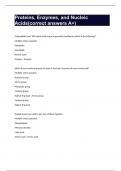Enzymes Study guides, Class notes & Summaries
Looking for the best study guides, study notes and summaries about Enzymes? On this page you'll find 33255 study documents about Enzymes.
Page 362 out of 33.255 results
Sort by
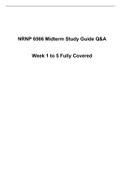
-
NRNP 6566 Midterm Study Guide Q&A Week 1 to 5 Fully Covered
- Exam (elaborations) • 18 pages • 2023
- Available in package deal
-
- $15.00
- + learn more
NRNP 6566 Midterm Study Guide Q&A Week 1 to 5 Fully Covered Week 1 1. Describe the cytochrome P450 system. Describe how inducers and inhibitors affect the cytochrome system and how that affects the half-life of medications. Cytochromes P450 (CYPs) are a superfamily of enzymes containing heme as a cofactor that function as monooxygenases. In mammals, these proteins oxidize steroids, fatty acids, and xenobiotics, and are important for the clearance of various compounds, as well as for h...
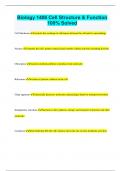
-
Biology 1406 Cell Structure & Function 100% Solved
- Exam (elaborations) • 2 pages • 2024
- Available in package deal
-
- $7.99
- + learn more
Biology 1406 Cell Structure & Function 100% Solved Cell Membrane controls the exchange of substances between the cell and its surroundings Nucleus contains the cell's genetic material and controls cellular activities including division Chloroplast location of photosynthesis to produce food molecules Ribosomes location of protein synthesis in the cell Golgi apparatus chemically processes molecules and packages them for transport elsewhere Endoplasmic reticulum functions in t...
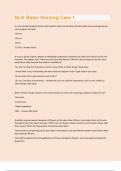
-
NLN Basic Nursing Care 1 Questions and Answers with complete solution
- Exam (elaborations) • 14 pages • 2024
- Available in package deal
-
- $7.99
- + learn more
A nurse should recognize that an adult patient with normal kidney function will have an average hourly urine output of at least 100 mL 200 mL 50 mL 150 mL - Answer-50 mL A nurse is about to give a patient a medicated shampoo for treatment of pediculosis (head lice) for the first time. The patient asks, "Have you ever done this before?" Which of these responses by the nurse would most likely increase the patient's confidence? No, but I've read the instructions, and it's very similar...
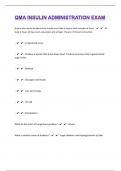
-
Qma Insulin Administration Exam 50 Questions with 100% Correct Answers | Verified | Latest Update
- Exam (elaborations) • 5 pages • 2023
- Available in package deal
-
- $7.49
- + learn more
A qma who wants to administer insulin must take a course that includes at least: - ️️At least 4 hours of classroom education and at least 2 hours of clinical instruction. - ️️A registered nurse - ️️Produce enzymes that break down food. Produce hormones that regulate blood sugar levels. - ️️Maltase - ️️Glucagon and Insulin - ️️Low and energy - ️️70-110 - ️️Ketoacidosis What do the Islet's of Langerhans produce? - ️️Insulin Wha...
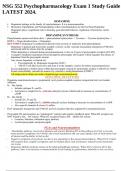
-
Summary NSG 552 Psychopharmacology Exam 1 Study Guide LATEST 2024.
- Summary • 27 pages • 2024
-
- $10.99
- + learn more
Summary NSG 552 Psychopharmacology Exam 1 Study Guide LATEST 2024. DOPAMINE • Dopamine belongs to the family of catecholamines. It is a neurotransmitter. • Hormones, Epinephrine and Norepinephrine (other catecholamines) are derived from Dopamine • Dopamine plays a significant role in learning, goal-directed behavior, regulation of hormones, motor control. DOPAMINE SYNTHESIS Phenylalanine (amino acid from diet) -> phenyalanine hydroxylase -> Tyrosine -> Tyrosine hydroxylase ...
IB Biology Unit 3: Proteins, Enzymes, and Nucleic Acid
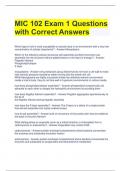
-
MIC 102 Exam 1 Questions with Correct Answers
- Exam (elaborations) • 6 pages • 2023
-
Available in package deal
-
- $10.49
- + learn more
MIC 102 Exam 1 Questions with Correct Answers Which type of cell is most susceptible to osmotic lysis in an environment with a very low concentration of solutes (hypotonic)? - Answer-Mycoplasma Which of the following cellular structures self-assemble (purified monomers can assemble into the structure without added factors or the input of energy)? - AnswerFlagellar filament Phospholipid bilayer S layer mycoplasma - Answer-only prokaryotic group listed that do not have a cell wall to res...
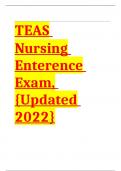
-
TEAS Nursing Enterence Exam C Correct Answer
- Exam (elaborations) • 29 pages • 2023
-
- $13.06
- + learn more
TEAS Nursing Enterence Exam C Correct Answer: When the chromosomes line up in mitosis this is known as which phase? A. Telophase B. Anaphase C. Metaphase D. Prophase B Correct Answer: Which cellular organelle contains enzymes that are considered digestive?
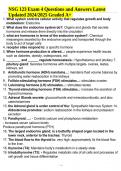
-
NSG 123 Exam 4 Questions and Answers Latest Updated 2024/2025 Graded A+ | 100% Verified.
- Exam (elaborations) • 45 pages • 2024
-
- $15.49
- + learn more
NSG 123 Exam 4 Questions and Answers Latest Updated 2024/2025 Graded A+ | 100% Verified. What does the endocrine system do?: Organs and glands that secrete hormones and release them directly into the circulation 3. what are hormones in terms of the endocrine system?: Chemical messengers secreted by the endocrine organs and transported through the body to act of target cells 4. receptor sites respond to: a specific hormone 5. When hormone production is altered...: people experience health i...
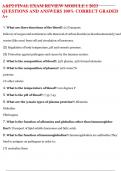
-
A&P2 FINAL EXAM REVIEW MODULE 1 2023 QUESTIONS AND ANSWERS 100% CORRECT GRADED A+
- Exam (elaborations) • 38 pages • 2023
-
- $14.99
- + learn more
1. What are three functions of the blood?: (1) Transport. Delivery of oxygen and nutrients to cells. Removal of carbon dioxide (as bicarbonate mainly) and wastes (like urea) from cell and circulation of hormones. (2) Regulation of body temperature, pH and osmotic pressure. (3) Protection against pathogens and cancer by the immune system. 2. What is the composition of blood?: 55% plasma, 45% formed elements 3. What is the composition of plasma?: 92% water 7% proteins 1% other solutes 4. Wh...
-
1
- ...
-
361
-
362
-
363
- ...

Study stress? For sellers on Stuvia, these are actually golden times. KA-CHING! Earn from your study resources too and start uploading now. Discover all about earning on Stuvia



